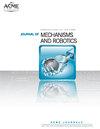Light-weight Design of 5-DoF hybrid robot for assembling in the cabin
IF 3.2
4区 计算机科学
Q2 ENGINEERING, MECHANICAL
Journal of Mechanisms and Robotics-Transactions of the Asme
Pub Date : 2023-03-08
DOI:10.1115/1.4057074
引用次数: 1
Abstract
Interior assembling inside the cabin of an aircraft requires assembling robot to be light-weight and able to carry heavy payload. This paper proposed a hybrid robot, carried out its optimal design and experiments. The robot consists of a 1T2R parallel module and a 2T serial module. In the parallel module, the 1st limb is composed of a slider-crank mechanism and a RS link. The other two limbs are PRS limbs. Herein, R, S, P are revolute, spherical and actuated prismatic joints. Optimization of the robot concerns motion/force transmissibility, total mass and stiffness. Hence, kinematic, stiffness and mass modeling are implemented, and then the Pareto-based multi-objective optimization. Objective arrangements are discussed by concerning (1) the conflicting relation between mass and the minimal linear stiffness along z-axis, and (2) the overall stiffness performance. After comparing six multi-objective optimizations, it is found that simultaneously regarding mass and minimal linear stiffness along z-axis as objectives is beneficial for obtaining large payload-to-mass ratio. Moreover, having overall stiffness as objectives would lower the values of motion/force transmissibility and payload-to-mass ratio. Finally, optimization model having motion/force transmissibility, total mass and minimal linear stiffness along z-axis as objectives is selected. The optimal payload-to-mass ratio is up to 13.2837. The 5-DoF hybrid robot is machined and assembled. Experiments on the workspace, repeatability and load carrying capacity confirm the performances of the designed robot.舱内组装5-DoF混合机器人的轻量化设计
飞机客舱内部组装要求组装机器人重量轻,能够携带重型有效载荷。本文提出了一种混合机器人,并对其进行了优化设计和实验。该机器人由一个1T2R并行模块和一个2T串行模块组成。在并联模块中,第一支路由曲柄滑块机构和RS连杆组成。其他两个肢体是PRS肢体。这里,R、S、P是旋转的、球形的和致动的棱柱关节。机器人的优化涉及运动/力传递性、总质量和刚度。因此,实现了运动学、刚度和质量建模,然后进行了基于Pareto的多目标优化。通过考虑(1)质量和沿z轴的最小线性刚度之间的冲突关系,以及(2)整体刚度性能,讨论了目标布置。通过对六个多目标优化的比较,发现同时以质量和沿z轴的最小线性刚度为目标有利于获得大的有效载荷质量比。此外,将整体刚度作为目标将降低运动/力传递性和有效载荷与质量比的值。最后,选择了以运动/力传递性、总质量和沿z轴的最小线性刚度为目标的优化模型。最佳有效载荷与质量比高达13.2837。5-DoF混合机器人经过机械加工和组装。工作空间、重复性和承载能力的实验验证了所设计机器人的性能。
本文章由计算机程序翻译,如有差异,请以英文原文为准。
求助全文
约1分钟内获得全文
求助全文
来源期刊

Journal of Mechanisms and Robotics-Transactions of the Asme
ENGINEERING, MECHANICAL-ROBOTICS
CiteScore
5.60
自引率
15.40%
发文量
131
审稿时长
4.5 months
期刊介绍:
Fundamental theory, algorithms, design, manufacture, and experimental validation for mechanisms and robots; Theoretical and applied kinematics; Mechanism synthesis and design; Analysis and design of robot manipulators, hands and legs, soft robotics, compliant mechanisms, origami and folded robots, printed robots, and haptic devices; Novel fabrication; Actuation and control techniques for mechanisms and robotics; Bio-inspired approaches to mechanism and robot design; Mechanics and design of micro- and nano-scale devices.
 求助内容:
求助内容: 应助结果提醒方式:
应助结果提醒方式:


